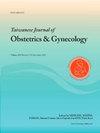胎母出血与胎儿生长受限和脐带异常的关系:一项全国性的观察性研究
IF 2
4区 医学
Q2 OBSTETRICS & GYNECOLOGY
引用次数: 0
摘要
目的探讨胎母出血(FMH)对新生儿预后的影响。然而,由于其罕见性,FMH发生的危险因素及其预后因素尚不清楚。因此,我们的目的是调查FMH发生的因素和相关结果。材料和方法我们纳入了2013年至2019年日本全国围产期登记数据库中的单胎孕妇。为了研究特征与FMH发生之间的关系,我们进行了多变量logistic回归模型分析。此外,我们采用多变量logistic回归模型来评估FMH中死产或新生儿死亡的预后因素。在所有分析中,我们都使用了多重输入来处理缺失数据。结果1,500,309例妇女中,141例(1/10,640)发生FMH。只有20.6%的FMH妇女检测到正弦模式。有FMH的妇女发生胎儿生长受限(FGR)的比例为10/141(7.1%),无FMH的妇女发生FGR的比例为54,989/1,500,168(3.7%)。有和没有FMH的女性分别在2/141(1.4%)和3845/1,500,168(0.3%)中发现单一脐动脉。FGR和单一脐动脉与FMH发生显著相关(校正优势比[OR], 2.01;95%置信区间[CI], 1.06-3.83;p = 0.033)(调整OR为5.51;95% ci, 1.36-22.27;P = 0.017)。此外,异常脐带插入与FMH中死产或新生儿死亡显著相关(校正or, 19.95;95% ci, 2.33-170.63;P = 0.006)。结论FMH的发生与FGR和单根脐动脉有显著相关性。此外,异常脐带插入与FMH患者的死产或新生儿死亡显著相关。我们需要对FGR或单脐动脉女性FMH的发生保持谨慎。此外,FMH妇女的围产期结局,特别是脐带插入异常的妇女,将是不利的。本文章由计算机程序翻译,如有差异,请以英文原文为准。
The associations of fetomaternal hemorrhage with fetal growth restriction and umbilical cord abnormalities: A nationwide observational study
Objective
Fetomaternal hemorrhage (FMH) causes severe neonatal outcomes; however, due to its rarity, risk factors for FMH occurrence and prognostic factors for its outcomes remain unclear. Thus, we aimed to investigate factors for FMH occurrence and related outcomes.
Materials and methods
We included singleton pregnant women from the Japanese nationwide perinatal registry database between 2013 and 2019. To investigate the association between characteristics and FMH occurrence, we conducted multivariable logistic regression model analyses. In addition, we employed multivariable logistic regression models to evaluate prognostic factors of stillbirth or neonatal death among FMH. We used multiple imputation to handle missing data in all analyses.
Results
Of 1,500,309 women, FMH occurred in 141 (1/10,640). A sinusoidal pattern was detected in only 20.6 % of women with FMH. The proportion of women who had fetal growth restriction (FGR) was 10/141 (7.1 %) in those with FMH and 54,989/1,500,168 (3.7 %) in those without FMH. A single umbilical artery was found in 2/141 (1.4 %) and 3845/1,500,168 (0.3 %) women with and without FMH, respectively. FGR and a single umbilical artery were significantly associated with FMH occurrence (adjusted odds ratio [OR], 2.01; 95 % confidence interval [CI], 1.06–3.83; p = 0.033) (adjusted OR, 5.51; 95 % CI, 1.36–22.27; p = 0.017), respectively. In addition, abnormal umbilical cord insertion was significantly associated with stillbirth or neonatal death among FMH (adjusted OR, 19.95; 95 % CI, 2.33–170.63; p = 0.006).
Conclusion
The occurrence of FMH was significantly associated with FGR and a single umbilical artery. In addition, abnormal umbilical cord insertion was significantly associated with stillbirth or neonatal death among those with FMH. We need to be cautious regarding FMH occurrence in women with FGR or a single umbilical artery. In addition, perinatal outcomes in women with FMH, especially those with abnormal umbilical cord insertion, would be adverse.
求助全文
通过发布文献求助,成功后即可免费获取论文全文。
去求助
来源期刊

Taiwanese Journal of Obstetrics & Gynecology
OBSTETRICS & GYNECOLOGY-
CiteScore
3.60
自引率
23.80%
发文量
207
审稿时长
4-8 weeks
期刊介绍:
Taiwanese Journal of Obstetrics and Gynecology is a peer-reviewed journal and open access publishing editorials, reviews, original articles, short communications, case reports, research letters, correspondence and letters to the editor in the field of obstetrics and gynecology.
The aims of the journal are to:
1.Publish cutting-edge, innovative and topical research that addresses screening, diagnosis, management and care in women''s health
2.Deliver evidence-based information
3.Promote the sharing of clinical experience
4.Address women-related health promotion
The journal provides comprehensive coverage of topics in obstetrics & gynecology and women''s health including maternal-fetal medicine, reproductive endocrinology/infertility, and gynecologic oncology. Taiwan Association of Obstetrics and Gynecology.
 求助内容:
求助内容: 应助结果提醒方式:
应助结果提醒方式:


